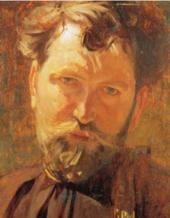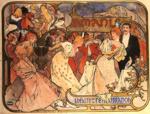Alphonse Mucha Biography

Alphonse (Alfons) Mucha (1860-1939) was a prolific Moravian painter of the late 19th and early 20th Centuries and a key figure in the Art Nouveau movement. His style of painting influenced an entire generation of painters, graphic artists, draughtsmen and designers and in the minds of many, his work epitomizes the Art Nouveau. He himself came to resent his fame as an artist of the utilitarian, believing that true art should be elevated and epic.
Alfons Mucha was born on July 24, 1860, in the town of Ivancice, Moravia, then part of Austro-Hungary. His father was a court usher, and the family had but modest means. The future painter was raised in an atmosphere of strict Roman Catholicism, and this would later be reflected in the symbolism he employed in his work.
In 1871, Mucha joined the choir at St. Peter's Cathedral in Brno, where he was attending grammar school. He pursued singing seriously for a while, but was forced to abandon it after his voice started cracking in 1875. Instead, Mucha took up drawing lessons. Soon afterwards, he returned to Ivancice where, in the meanwhile, he found work as a municipal clerk.
In 1877, the young man applied to the Academy of Visual Arts in Prague, but was unable to gain admission. This did not discourage him, however, and he continued attending drawing classes. In 1879, he got a job in Vienna as an assistant in a firm that made stage sets, which is where he gained familiarity with theatre and the art of interior decoration. He was laid off in 1882, after a fire in the Burg Theater -- where the company had been working -- put the firm in difficult financial straits.
At this point, Mucha was feeling confident enough in his artistic skills to take up portrait painting. He moved back to Moravia, to the town of Mikulov, and it was there that he met Count Karl Khuen-Belassi, a local nobleman, who commissioned him to decorate the Emmahof Castle. The Count was so impressed with Mucha's work that he agreed to sponsor the artist's formal education. In 1884, after touring northern Italy and Austria with his patron, the painter entered the Academy of Visual Arts in Milan.
While at the Academy, Mucha became chairman of the Association of Slavic Painters, a first sure sign of his patriotic views.
In 1888, Mucha visited Paris for the first time. Paris, Europe's undisputed artistic capital of the time, was an essential step in the education of any "serious" painter. Mucha studied at the Academie Julian and the Academie Colarossi, focusing on academic historical painting. He was also involved with the Symbolists and artistic circles close to them.
Although he was a technically adept painter, academic art was long past its peak of popularity, and, as a means of supporting himself, Mucha began to draw illustrations for books and magazines.
In 1892, the painter designed his first advertising poster. Finding this line of work profitable, he began taking regular commissions and, in 1894, he designed a poster for the show "Gismonda" of the highly popular stage actress Sarah Bernhardt. The poster was revolutionary, bringing unheard of innovations to the art of poster-printing, which had hitherto consisted of large amounts of text with a few simple illustrations, usually in just one or two colors. The Gismonda poster (1892) employed a radically new vertical format -- a legacy of which we can see in posters today -- and an unheard-of amount of colors and detail.
For Mucha, who had been a nearly unknown artist up to this point, this was a breakthrough. Sarah Bernhardt was so impressed with his work that she immediately offered the artist an exclusive six-year contract. The posters that Mucha produced for her include: La Dame aux Camelias (1896), Lorenzaccio (1896), La Samaritaine (1897), Medee (1898), Hamlet (1899) and Tosca (1899). During this time, he was also responsible for the stage sets and costumes at the Theatre de la Renaissance, where Bernhardt worked.
In 1896, Mucha designed his first panneaux decoratifs: The Seasons (1896). Panneaux decoratifs were limited-edition large-size prints executed on silk or stiff papers, often ornately framed, hung on walls or screens. Usually, these featured highly stylized nature scenes, inspired by the silk screen paintings of the Orient. Mucha would produce several series of these, including: Flowers (1898), the Arts (1898), the Months (1899), Gemstones (1900) and Stars (1901).
Although the painter thought of his Art Nouveau work as scarcely more than a means of earning money to enable him to pursue more serious things, critics thought differently. In 1897, the painter had his first one-man exhibition at the Galerie La Bodiniere. Later that year, a second, much larger exhibition was held at the Salon de Cent, and proceeded to tour Europe.
In 1898, the painter was invited to teach drawing lessons at the Academie Carmen. He accepted.
That summer, deciding to take a break from Paris and his daily work on posters and illustrations, the artist went abroad to visit Spain and then the Balkan states.
It was at around this time that Mucha began his collaboration with the known Parisian jeweler Georges Fouquet. Together, they created a number of pieces featuring Mucha's trademark style. The painter also designed the façade and interior of Fouquet's shop, giving the jeweller's boutique an extravagant, almost temple-like setting.
In 1902, with interest in Art Nouveau beginning to wane, Mucha travelled to his homeland, visiting Moravia and Prague. To him, his Art Noveau work had been something frivolous and unimportant, so he was not particularly disappointed that it had fallen out of fashion. In fact, this was only to be expected, for he believed that the only "true" art was academic. It was during his 1902 trip home that the artist became infected with the idea of painting a series of epic patriotic works, showing the somewhat fictionalized history of the Slavic people in a grand, neo-classical style.
In 1904, he made a brief visit to the USA, in the hopes of raising additional money. He picked up portrait commissions and also lectured in New York, Philadelphia and Chicago. Soon, he returned to Europe and began preparations for what he would consider his own greatest work.
In 1906, Mucha married Maria Chytilova, a fellow Moravian whom he had met in Paris.
Over the following years, he devoted himself to painting the Slavic Epic, a series of twenty monumental canvasses. This project consumed so much of his time and energy that the once-extremely popular artist fell into near obscurity during this period.
Though Mucha considered this to be the most meaningful work of his life, the paintings were received rather coldly by the European public, due to changing tastes and also probably to the First World War, raging at the time. The New World accepted them rather more enthusiastically, when part of the Slavic Epic was exhibited in New York in 1921. However, the paintings were never nearly as successful as Mucha's early Art Nouveau works.
In 1920, Czechoslovakia gained its independence from Austro-Hungary as part of the aftermath of the First World War. Mucha, who had always sympathized with the cause of Slavic separatism, went enthusiastically to work for the new government, designing banknotes and official documents for the new state.
Although Mucha continued to paint until the very end of his life, his artistic heyday was, by this point, well over. A fairly affluent and politically active individual, Mucha devoted the rest of his life to indulging his love for academic painting. He made no more revolutionary innovations that had characterized his early artistic career.
In 1928, Mucha gave his long-suffering Slavic Epic as a gift to the Czech people and the City of Prague.
In 1936, the artist published his memoirs "Three Statements on my Life and Work."
Two years later, in 1938, Czechoslovakia was taken over by Nazi Germany, as a result of the Munich Agreement between the governments of Germany, Britain and France (Czechoslovakia was never invited to the negotiations). Since the suppression of nationalism was high on the agenda of the conquerors, Mucha, with his history of patriotism and Pan-Slavism, was arrested and incarcerated by the Gestapo.
Already an old man by this time, the painter caught pneumonia and died in prison on 14th July, 1939. His last work of art was the Slavs' Oath of Unity (1939).
Bibliography
Alphonse Mucha by Sarah Mucha. Frances Lincoln, 2007.
Alphonse Mucha: The Spirit of Art Nouveau by Victor Arwas, Jana Brabcova-Orlikova, Anna Dvorak Yale University Press, 1998.
The Art Nouveau Style Book of Alphonse Mucha by Alphonse Mucha. Dover Publications, 1980.
Biography by Olga Mataev and Yuri Mataev
- Gismonda.

1894. Color lithograph. 216 x 74.2 cm.
- La Dame Aux Camélias.

1896. Color lithograph. 207.5 x 76.2 cm.
- Lorenzaccio.

1899. Color lithograph. 207.5 x 76 cm.
- La Samaritaine.

1897. Color lithograph. 175 x 58.3 cm.
- Medée.

1898. Color lithograph. 206 x 76 cm. Read Note.
- Hamlet.

1899. Color lithograph. 207.5 x 76.5 cm.
- Flower.

1894. Oil on canvas. 66 x 41 cm. Private collection.
- Cassan Fils.

1895. Color lithograph. 203.7 x 76 cm.
- Amants.

1895. Color lithograph.